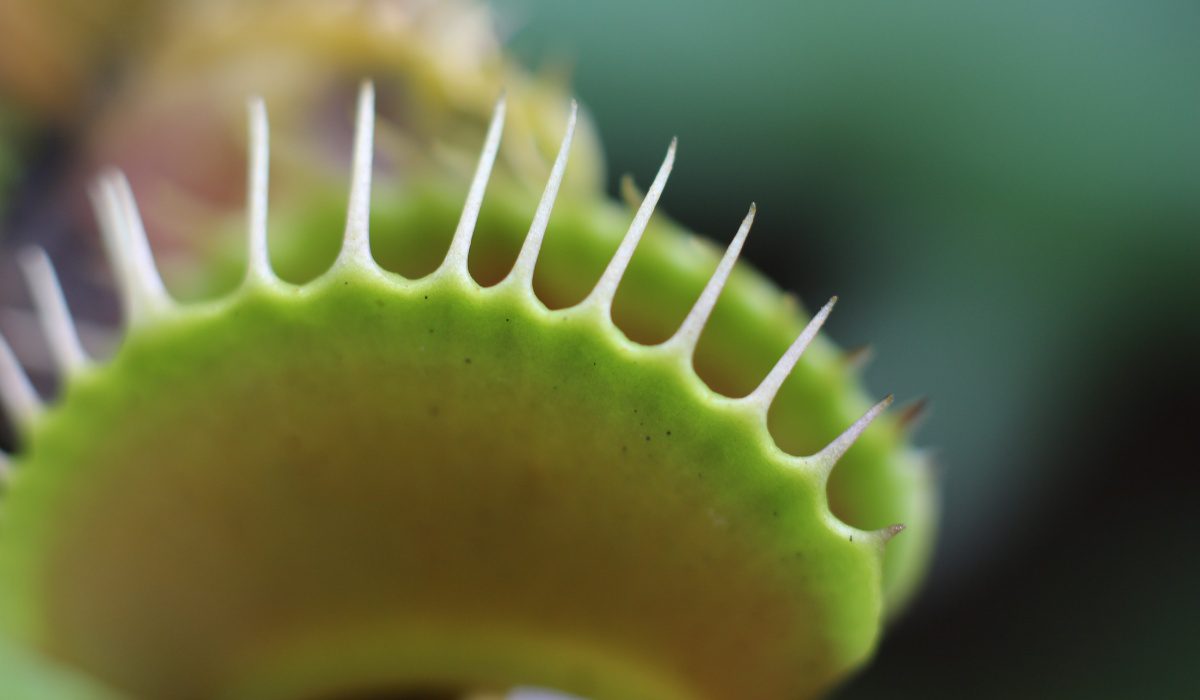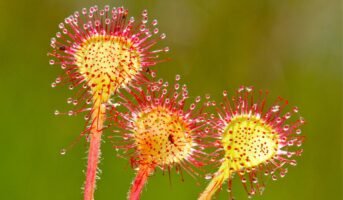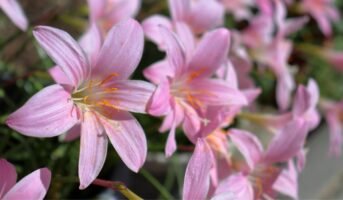Different houseplants offer different benefits. The superpower of Venus Flytrap is keeping your home insect-free. This perennial carnivore catches and digests small insects, earning the titular Flytrap, through a process known as thigmonasty.
See also: All about insect eating plants
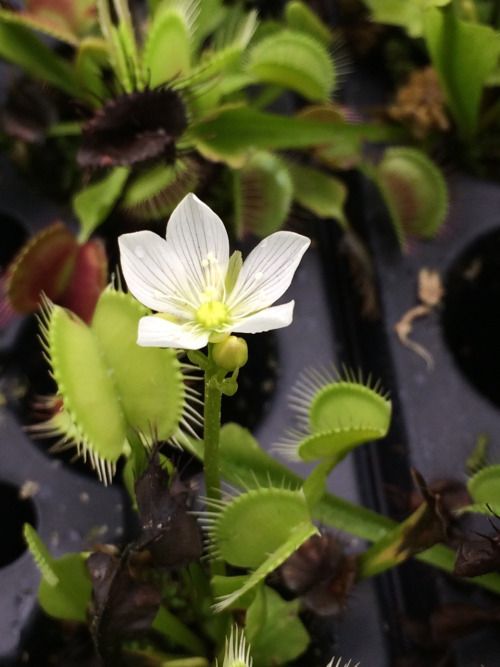
Source: Pinterest
A native of damp and mossy areas in South and North Carolina in the US, the Venus Flytrap has a trapping structure. The trap is made of two hinged lobes at the end of each leaf. They lure insects with the reddish lining in the leaves, secreting fragrant nectar and emitting a fluorescent blue glow. The inner surface of the lobes carries super-sensitive trichomes, i.e., hair-like projections, which cause the lobes to snap shut when the prey comes in contact.
The petals will close shut only if there are at least two movements within 20 seconds.
A strange mix of bold and beautiful, the carnivore plant is sophisticated to look at. According to British naturalist, John Ellis, the ‘beautiful appearance of its milk-white flowers and the elegance of its leaves’ inspired the name of the inspect-killer plant. Charles Darwin was among the many admirers of the Venus Flytrap.
Known about common jasmine
Venus Flytrap: Facts
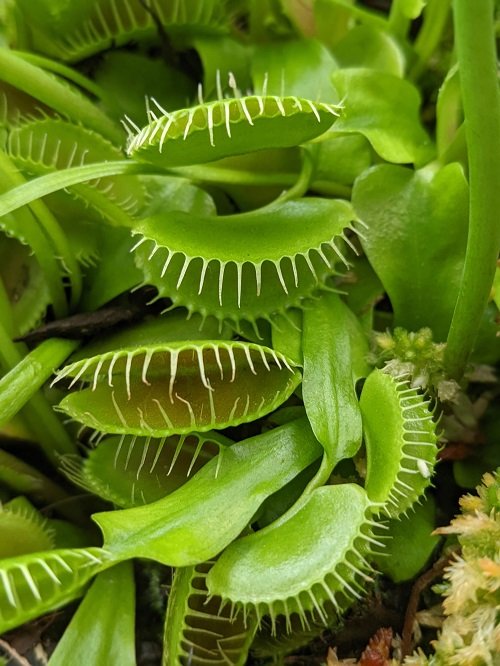
| Common name: Venus Flytrap
Botanical name: Dionaea muscipula Family: Sundew Plant type: Perennial carnivore Native: North and South Carolina Sun: Full Soil: Acidic, moist |
A perennial plant that blooms year after year, the Venus Flytrap bears white flowers with green veins, running from the base of the petal toward the edges.
Potted in all parts of the world as a house plant, the Venus Flytrap can grow in moist, acidic soil. It relies largely on its prey for nutrients, hence, can grow well in less nutrient-rich soil. The Venus Flytrap can keep growing without any feeding for months and can grow to around 13 cm in diameter.
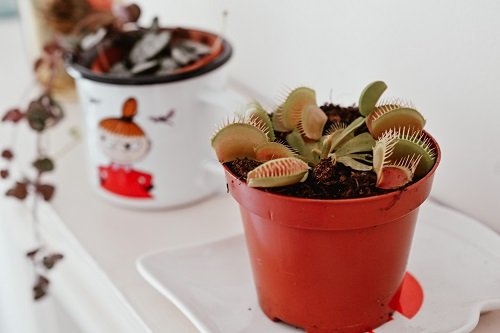
Listed as an endangered species (the plant is listed as vulnerable by the International Union for Conservation of Nature’s Red List of Threatened Species; they are also considered as a ‘Species of Special Concern’ in North Carolina), the Venus Flytrap gets its energy from the sun through photosynthesis.
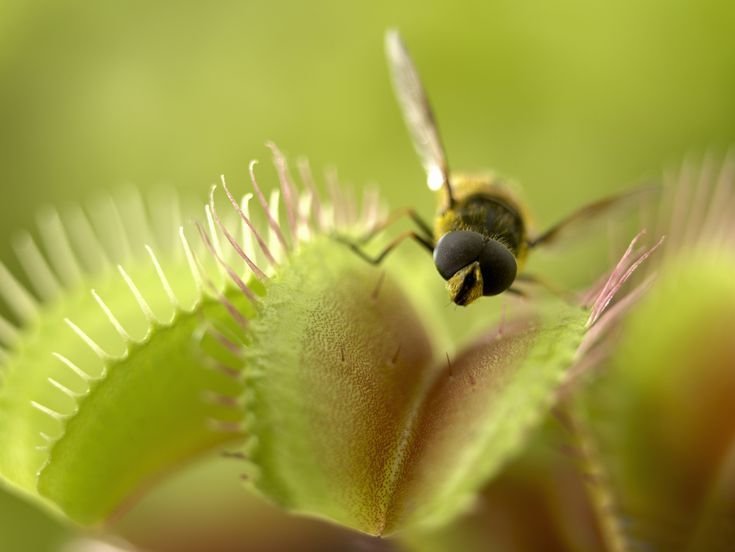
Source: Pinterest
One of the easiest carnivorous plants to grow, the Venus Flytrap could live up to 20 years. Each trap can open and shut several times before drying up and falling off the plant.
They are a subject of intrigue for botanists since they hardly ever trap their pollinators. The Venus Flytrap is pollinated by flying insects but they only prey on crawling insects.
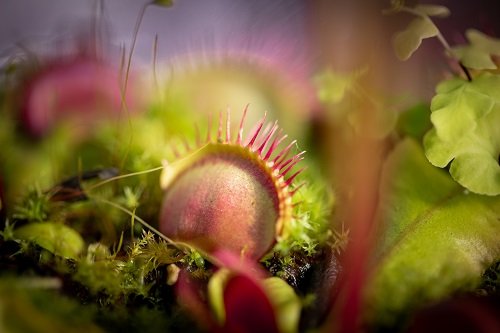
Where to grow Venus Flytrap?
These plants can be grown outside and as house plants too for as long as you are able to mimic their natural habitat.
Types of Venus Flytraps
Akai Ryu
Alien
B52
Blanche Hermine
Bohemian Garnet
Clayton’s Red Sunset
Coquillage
Cupped Trap
Dentate Traps
Fondue
Fused Tooth
Green Dragon
Holland Red
JA1
Jaws
Justina Davis
Korean Melody Shark
Korrigans
Louchapates
Microdent
Mirror
Petite Dragon
Red Burgundy
Orange Neat
Red Pirhana
Red Neat Trap
Royal Red
Sawtooth
Scarlatin
Small Fats
Scarlet Bristle
Viper Trap
Wacky Traps
Big Mouth
Clumping Cultivar
Dente
Dentate
Kinchyaku
Red Rosetted
Venus Flytrap care tips
- Avoid any nutrient-rich soil or amendment.
- Feeding your flytrap is not necessary.
- Venus Flytraps love water and need to be kept moist at all times. Depending on the time of year and where you live, you’ll typically need to water every two to four days.
- If your plant becomes sickly, it probably isn’t receiving enough sunlight. While 10 to 12 hours of sunlight per day is ideal, they need at least 6 hours of direct sunlight daily.
What to feed a Venus Flytrap plant?
The soil of the plant should not be fertilised because it will slowly kill your plant. This is because in its natural habitat, the soil is low in nutrients, and the Venus flytrap has adapted to an unusual feeding strategy. Live prey, such as flies, spiders, crickets and slugs would do just fine. Do not feed your Venus’ fly Trap meat.
FAQs
Can Venus Flytrap hurt a person?
No, Venus Flytrap can only hurt small insects like houseflies.
Why shouldn’t you touch a Venus Flytrap?
The plant is sensitive to touch and its growth can be impacted by human contact. The plant would reflect this by shedding leaves. However, touching a Venus flytrap through the base of its leaves is alright and has no impact.
What does the Venus Flytrap eat?
Venus Flytraps can move rapidly enough to capture bugs and sometimes small mammals. While its primary prey is ants, the Venus Flytrap also eats flies, beetles, slugs, spiders and tiny frogs.
Does a Venus Flytrap eat flies?
Yes, a Venus Flytrap captures and slowly digests a fly over 2-3 days.
Are Venus Flytraps harmful to humans?
No, Venus Flytraps are not harmful to humans. However, Dionaea muscipula can digest strips of human skin if placed in its pods.
Is it safe to keep a Venus Flytrap indoors?
Yes, it is safe to keep a Venus Flytrap indoors.

An alumna of the Indian Institute of Mass Communication, Dhenkanal, Sunita Mishra brings over 16 years of expertise to the fields of legal matters, financial insights, and property market trends. Recognised for her ability to elucidate complex topics, her articles serve as a go-to resource for home buyers navigating intricate subjects. Through her extensive career, she has been associated with esteemed organisations like the Financial Express, Hindustan Times, Network18, All India Radio, and Business Standard.
In addition to her professional accomplishments, Sunita holds an MA degree in Sanskrit, with a specialisation in Indian Philosophy, from Delhi University. Outside of her work schedule, she likes to unwind by practising Yoga, and pursues her passion for travel.
sunita.mishra@proptiger.com
